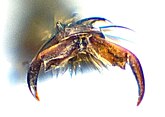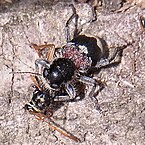Oak beetle
| Oak beetle | ||||||||||||
|---|---|---|---|---|---|---|---|---|---|---|---|---|

Oak |
||||||||||||
| Systematics | ||||||||||||
|
||||||||||||
| Scientific name | ||||||||||||
| Clerus mutillarius | ||||||||||||
| ( Fabricius , 1775) |
The oak colored beetle ( Clerus mutillarius ) is a beetle from the family of the colored beetles and the subfamily Clerinae . The beetle, which used to be common in Central Europe, is rare to very rare here today. In the Red List of Germany it is classified as "critically endangered", in some country lists as extinct . In Appendix 1 to the Federal Species Protection Ordinance , it is listed as a "strictly protected" and as a "specially protected" beetle.
Comments on the name and system
The species name mutillarius indicates the similarity to an ant wasp ( Mutilla ). The generic name Clerus (from ancient Greek κλήρος klēros) was chosen by Geoffroy after an insect which, according to Aristotle , is harmful in beehives. In Fabricius , the genus contains four species in 1775 , three of which were later placed in other genera. Today the genus is only represented by the species Clerus mutillarius . The name oak beetle can be explained by the fact that the species belonging to the beetle family is often found on felled oaks.
Characteristics of the beetle
The body is about three times as long as it is wide. It is arched and reaches a length of nine to fifteen millimeters. The belly is red, the rest of the body black. The wing covers are colorful.
The head is sloping downwards. The last link of the jaw feeler is elongated and narrowly truncated (in Fig. 1 laterally below the jaw), the last link of the well-developed lip feeler is ax-shaped (in Fig. 3 under the eye on the upper half of the picture). The eleven-limbed antennae are thread-shaped, the first limbs very slender, the latter thicker and somewhat widened inward, especially the last three. The compound eyes are large, deeply indented in front and set high on the head (Fig. 2). On the vertex, the inner edges of the eyes are only about the width of the eye apart (Fig. 4).
The pronotum is black. It is inflated on both sides in the middle, sharply narrowed towards the back and constricted at the base (Fig. 4).
The wing covers are pulled forward on the shoulders, run parallel on the sides and are rounded together in a semicircle at the back. They are dotted in rows , the rows become indistinct towards the back. The front quarter of the elytra is red with the exception of the black shoulder bump. To the rear, the red section is bounded by a narrow white cross band, which, however, can be reduced to a few white spots. A second transverse band runs in the last third of the wing. It is broad and wavy, covered with chalk-white scales and widened towards the front in the middle of the wing cover.
The front hips are very close together, the front hip cavities are not closed. The rear hips are broadly separated (Fig. 3). The legs are hairy and strong and sticking out long. They enable swift locomotion. The tarsi are clearly five-limbed (Fig. 6). When viewed from above, the second tarsal segment is hardly longer than the basal segment (Fig. 4). The front tarsi are no wider than the other tarsi. The claws have a small tooth at the base (Fig. 5).
 Fig. 1: Front view Fig. 2: Side view Fig. 3: Bottom   |
 Fig. 4: Top view Fig. 5: Claw rear foot Fig. 6: Metatarsus from inside   |
  Fig. 7: Overcoming a longhorn beetle |
|
biology
The beetle lives on old wood from various deciduous trees, especially oak, which has been eaten away by insects and other arthropods . Beetles and larvae are predatory (Fig. 7). The adult beetle can be found from May to August. He is a nimble runner, often remains motionless for a long time and also likes to be blown.
distribution
The beetle, which used to be widespread in Central Europe, is now only found very locally and is classified as rare to very rare. Only in eastern Austria is it less rare. Southern and Central Europe and North Africa are specified as the distribution area.
literature
- Heinz Joy, Karl Wilhelm Harde, Gustav Adolf Lohse: The beetles of Central Europe . tape 6 : Diversicornia . Spectrum, Heidelberg 1979, ISBN 3-87263-027-X .
- Klaus Koch : The Beetles of Central Europe Ecology . 1st edition. tape 2 . Goecke & Evers, Krefeld 1989, ISBN 3-87263-040-7 .
Individual evidence
- ↑ Clerus mutillarius in Fauna Europaea. Retrieved December 16, 2010.
- ^ Red list of the colored beetles of the state of Saxony-Anhalt. (PDF)
- ↑ Red List of Endangered Diversicornia Bavaria (PDF)
- ↑ Sigmund Schenkling: Explanation of the scientific beetle names (species)
- ↑ Sigmund Schenkling: Explanation of the scientific beetle names (genus)
- ↑ ELGeoffroy: Histoire des insectes abrégée qui se trouvent aux environs de Paris; First description of the genus in GDZ p. 303.
- ↑ Aristotle: Historia Animalium. 8th book part 27 350 BC Chr. Section 27 is not visible when calling up Book 8, only when calling up the complete works
- ↑ JC Fabricius: Systema entomologiae, sistens insectorvm classes, ordines, genera, species, adiectis synonymis, locis, descriptionibvs, observationibvs Flensburg Leipzig 1775 Original description of the species in GDZ p.157
- ↑ Clerus in Fauna Europaea. Retrieved February 15, 2013.
- ↑ Clerus at BioLib
- ^ Website of the working group of Southwest German Coleopterologists